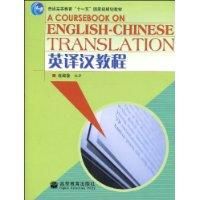基本信息
·出版社:高等教育出版社·頁碼:367頁
·出版日期:2007年12月
 英譯漢教程
英譯漢教程·ISBN:7040189380
·條形碼:9787040189384
·版本:第1版
·裝幀:平裝
·開本:16
·正文語種:英語/中文
·叢書名:普通高等教育“十一五”國家級規劃教材
內容簡介
《英譯漢教程》將翻譯理論課、技巧課和實踐課融為一體,提供了一套可供課堂操作的英漢翻譯基礎教程。本教材主要供高等院校英語專業本科高年級或同等程度的學生作為英漢翻譯課在課堂教學中使用,也可供有同等英語水平的翻譯自學者使用。作者簡介
連淑能(1942-),廈門大學外文學院教授、博士生導師,榮獲國務院頒發的政府特殊津貼。1996—1999年任廈門大學外文系系主任,1999—2003年任外文學院院長,現兼任中國英漢語比較研究會副會長、中國人文社會科學核心期刊《外語與外語教學》顧問和編委等。曾任駐外大使館和專家組翻譯,赴英國牛津大學和劍橋大學、美國俄勒岡大學和威拉姆特大學講學、研究。榮獲福建省“三育人先進個人”稱號、廈門市優秀教師稱號、廈門大學最高獎“南強獎”一等獎(合作)、廈門大學研究生“良師益友”稱號等。主要研究方向為漢英語言與中西文化、翻譯理論與技巧、跨文化交際學,已發表80多篇論文和18部論著、編著、譯著,合作承擔國家863計畫課題“自然語言理解與機器翻譯”,榮獲20多項獎項。代表作《英漢對比研究》榮獲國家教委頒發的第二屆全國高等學校出版社優秀學術著作優秀獎、福建省第三屆社會科學優秀成果一等獎,並被選送參加國際書展。目錄
Chapter1GeneraIPrlnclples11.1WhatisTranslation?1
1.1.1LinguisticViewsonTranslation1
1.1.2CulturalViewsonTranslation1
1.1.3LiteraryViewsonTranslation2
1.1.4SemanticViewsonTranslation2
1.1.5FunctionalViewsonTranslation3
1.1.6CommunicativeViewsonTranslation
1.2TheAssessmentofTranslation3
1.2.1TranslationCriteriaPutForwardbyFamousTranslatorsorTra
1.2.2OtherFactorsAffectingtheEvaluationofTranslation
1.2.3CriteriaforBeginnersofTranslation7
1.2.4TranslationProficiency:theRequirementsoftheTeachEnglishMajor
1.3TheCompetenceofaTranslator8
1.3.1ExcellentCommandoftheTwoLanguages8
1.3.2ConsiderableKnowledgeoftheTwoCultures9
1.3.3AdequateKnowledgeoftheSubjectMatter11
1.3.4FairCapacityforWriting11
1.3.5PlentyofPracticeandAdequateKnowledgeofTranslSkills11
1.3.6SkillsintheUseofInformationTechnology12
1.4TranslationStrategies12
1.4.1LiteralTranslationandFreeTranslation12
1.4.2ForeignizingTranslationandDomesticatingTranslation
1.4.3StyleandTranslation15
1.5BasicProcessesinTranslating19
1.5.1TheFour-phaseProcessinTranslating19
1.5.2SomeDosandDon'tsforStudents21
1.5.3ProceduresofTranslationbyaTeam21
Chapter2ContrastlveStudiesofEnglishandChinese25
2.1StudiesoftheEnglishLanguage25
2.1.1ExternalHistory:HistoricalInformationRelatedtotheEnglishLanguage25
2.1.2InternalHistory:aLinguisticReview28
2.1.3SomeCharacteristicsofEnglish29
2.2StudiesoftheChineseLanguage31
2.2.1SomeMajorFactorsAffectingtheChineseLanguage31
2.2.2SomeCharacteristicsofModernChinese32
2.3Englishvs.Chinese:TenPairsofFeatures38
2.3.1Syntheticvs.Analytic(綜合語與分析語)38
2.3.2Rigidvs.Supple(剛性與柔性)44
2.3.3Hypotacticvs.Paratactic(形合與意合)47
2.3.4Complexvs.Simplex(繁複與簡短)49
2.3.5impersonalvs.Personal(物稱與人稱)50
2.3.6Passivevs.Active(被動與主動)52
2.3.7Staticvs.Dynamic(靜態與動態)54
2.3.8Abstractvs.Concrete(抽象與具體)55
2.3.9Indirectvs.Direct(間接與直接)56
2.3.10Substitutivevs.Repetitive(替換與重複)59
Conclusion66
Chapter3DIction(選詞法)67
3.1ChoiceofAffectiveMeanings67
3.2ChoiceofGrammaticalMeanings70
3.3ChoiceofContextualMeanings71
3.4ChoiceofCollocativeMeanings72
3.5ChoiceofStylisticMeanings74
3.6ChoiceofambiguousMeanings81
3.7ChoiceofExtendedMeanings83
3.8ChoiceofEquivalentMeanings87
3.9ChoiceofExactMeanings92
3.10ChoiceofDifferentChineseWordstoTranslatetheSameEnglishWordorUseofthe
SameChineseWord(s)toTranslateDifferentEnglishWords95
Conclusion102
Chapter4Conversion(轉換法)103
4.1ConversionofWordClasses103
4.2ConversionofSentenceMembers114
4.3ConversionofImpersonalSubjects118
4.4ConversionofPerspectives125
Conclusion128
Chapter5Addltion(增神法)129
5.1StructuralAddition129
5.2SemanticAddition130
5.3RhetoricaIAddition140
Conclusion144
Chapter6Omission(省略法)146
6.1OmissionofWordsPeculiartoEnglish146
6.2OmissionofWordsSuperfluousinChinese149
Conclusion162
Chapter7Repetition(重複法)164
7.1GrammaticalRepetition165
7.2rhetoricalReduplicationandRepetition170
Conclusion183
Chapter8Invorslon(倒置法)164
8.1InversionofWordOrderinTranslatingWord-GroupsorPhrases184
8.2InversionofWordOrderinTranslatingAttributes185
8.3PositionofAdjectiveClauses188
8.4InversionofAdverbials193
8.5PositionofAdverbialClauses194
8.6InversionofSentenceStructure196
rnnchLlsinn205
Chapter9negation(反譯法)208
9.1TransferoftheNegative208
9.2ConversionoftheaffirmativeintotheNegative211
9.3ConversionoftheNegativeintotheAffirmative213
9.4TranslationofEnglishQuestionsandAnswers216
9.5TranslationofVariousKindsofNegations220
Conclusion251
Chapter10Dlvlslon(拆譯法)252
10.1PickingOutofWords252
10.2PickingOutofPhrases254
10.3SplittingofComplexSentences256
10.4SplittingoftheWholeSentence262
Conclusion268
Chapter11Condensation(縮譯法)270
11.1CondensationofPhrasesandClauses270
11.2CondensationofComplexSentencesintoSimpleSentences271
11.3CondensationofCompoundSentencesintoSimpleSentences273
11.4CondensationofTwoorMoreSimpleSentencesintoOneSimpleSentence273
Conclusion276
Chapter12TranslationofthePassive(被動與譯法)277
12.1FeaturesoftheEnglishPassive277
12.2FeaturesoftheChinesePassive279
12.3CommonWaystoTranslatetheEnglishPassive282
Conclusion289
Chapter13TranslationofLongSentences(長句譯法)290
13.1FeaturesofLongEnglishSentences290
Chapter14TranslationofCulture-loadedExpressions
Chapter15TransaltionofProperNounsandTechnicalTerms
……
